Development and Evaluation of Ferrite Core Inductively Coupled Plasma Radio Frequency Ion Source for High-Current Ion Implanters in Semiconductor Applications
Abstract
:1. Introduction
2. Materials and Methods
2.1. Ferrite Core ICP RF Ion Source Head
2.2. Ferrite Core ICP Source Head Improvement
2.3. Vacuum Chamber Design and Setup
3. Results and Discussions
3.1. Measurement of Ion Density Using Langmuir Probe and Extraction Current at Commercial Implanter
3.2. Comparison with Process Gas and IHC DC Ion Source Extraction Current Using High-Current Ion Implanter
3.3. Ferrite Core ICP Source Lifetime Test
4. Conclusions
Author Contributions
Funding
Institutional Review Board Statement
Informed Consent Statement
Data Availability Statement
Conflicts of Interest
References
- Olson, J.C.; Maciejowski, P.E.; Shengwu, C.; Klos, L. Varian Semiconductor Indirectly Heated Cathode Sources. In Proceedings of the 14th International Conference on Ion Implantation Technology, Taos, NM, USA, 22–27 September 2002. [Google Scholar] [CrossRef]
- Tanaka, K.; Umisedo, S.; Miyabayashi, K.; Fujita, H.; Kinoyama, T.; Hamamoto, N.; Yamashita, T.; Tanjyo, M. Nissin Ion Equipment Indirectly Heated Cathode Ion. In AIP Conference Proceedings, Proceedings of the ION IMPLANTATION TECHNOLOGY: 16th International Conference on Ion Implantation Technology—IIT 2006, Marseille, France, 11–16 June 2006; American Institute of Physics: College Park, MD, USA, 2006. [Google Scholar] [CrossRef]
- Makov, B.N. The Multiply Charged Ion Source with Indirectly Heated Cathode. IEEE Trans. Nucl. Sci. 1976, 23, 1035–1041. [Google Scholar] [CrossRef]
- Horsky, T.N.; Chen, J.; Reynolds, W.E.; Jones, M.A. Current Status of the Extended Life Source: Lifetime and Performance Improvements. In Proceedings of the 1998 International Conference on Ion Implantation Technology. Proceedings (Cat. No.98EX144), Kyoto, Japan, 22–26 June 1998. [Google Scholar] [CrossRef]
- Rathmeli, R.D.; Hsieh, T.J.; Trueira, F.R. Modifications to Improve Lifetime of the ELS Ion Source. In Proceedings of the 2000 International Conference on Ion Implantation Technology Proceedings. Ion Implantation Technology—2000 (Cat. No.00EX432), Alpbach, Austria, 17–22 September 2000. [Google Scholar] [CrossRef]
- Tang, Y.; Nien, V.; Ku, P.; Yang, H.; Lin, T.; Chen, W.; Tien, E. Performance Improvement on SMIT SHX-III High Current Ion Implanter through the Use of EnrichedPlus 72germanium Tetrafluoride (EnPlus 72GeF4) and Hydrogen (H2) Mixture Gases. MRS Adv. 2022, 7, 1398–1400. [Google Scholar] [CrossRef]
- Tang, Y.; Byl, O.; Yoon, Y.; Yedave, S.; Tien, B.-T.; Bishop, S.; Sweeney, J.; Woo, S.; Kang, J. Ion Implanter Performance Improvement for Boron Doping by Using Boron Trifluoride (BF3) and Hydrogen (H2) Mixture Gases. In Proceedings of the 2014 20th International Conference on Ion Implantation Technology (IIT), Portland, OR, USA, 26 June–4 July 2014. [Google Scholar] [CrossRef]
- Tang, Y.; Leong, C.W.; Lim, H.K.; Tiu, C.K.; Tien, E. Germanium Ion Implantation Performance Improvement on Applied Materials’ VIISta HCS High Current Implanter with Use of Germanium Tetrafluoride (GeF4) and hydrogen (H2) mixture gases. MRS Adv. 2022, 7, 1401–1403. [Google Scholar] [CrossRef]
- Sinha, A.K.; Heiderman, D.C.; Chiu, R.; Koo, B.-W.; Sporleder, D.; Smith, S.M.; Sinclair, F. UpTime® Si2H6/SiF4 Mix for High Productivity Si Implant. In Proceedings of the 2016 21st International Conference on Ion Implantation Technology (IIT), Tainan, Taiwan, 26–30 September 2016. [Google Scholar] [CrossRef]
- Srivastava, A.; Wilson, A.; Koo, I. Using a Remote Plasma Source for N-type Plasma Doping Chamber Cleans. In Proceedings of the 2014 20th International Conference on Ion Implantation Technology (IIT), Portland, OR, USA, 26 June–4 July 2014; IEEE: Piscataway, NJ, USA, 2014. [Google Scholar] [CrossRef]
- Cheon, C.; Yoon, J.H.; Jo, S.; Kim, H.J.; Lee, H.J. Importance of Higher-Level Excited Species in Argon Remote Plasma Sources: Numerical Modeling with Consideration of Detailed Chemical Reaction Pathways. Plasma Process. Polym. 2022, 19, 2100251. [Google Scholar] [CrossRef]
- Wu, T.-F.; Yu, L.-C.; Kumari, A. Remote Plasma Source Chamber Modeling and Generator Design. IEEE J. Emerg. Sel. Top. Power Electron. 2022, 10, 2075–2087. [Google Scholar] [CrossRef]
- Knoops, H.C.M.; Arts, K.; Buiter, J.W.; Martini, L.M.; Engeln, R.; Hemakumara, D.T.; Powell, M.; Kessels, E.; Hodson, C.J.; O’mahony, A. Innovative Remote Plasma Source for Atomic Layer Deposition for GaN Devices. J. Vac. Sci. Technol. A. Vac. Surf. Film. 2021, 39, 062403. [Google Scholar] [CrossRef]
- Yeom, H.J.; Choi, D.H.; Lee, Y.S.; Kim, J.H.; Seong, D.J.; You, S.J.; Lee, H.C. Plasma Density Measurement and Downstream Etching of Silicon and Silicon Oxide in Ar/NF3 Mixture Remote Plasma Source. Plasma Sci. Technol. 2019, 21, 064007. [Google Scholar] [CrossRef]
- Park, K.W.; Lee, T.I.; Hwang, H.S.; Noh, J.H.; Baik, H.K.; Song, K.M. Formation of Stable Direct Current Microhollow Cathode Discharge by Venturi Gas Flow System for Remote Plasma Source in Atmosphere. Appl. Phys. Lett. 2008, 92, 061503. [Google Scholar] [CrossRef]
- Horsky, T.; Chen, J.; Rutishauser, H.; Sinclair, F.; McIntyre, T.; Reynolds, B.; Cloutier, R.; Trueira, F.; Loizides, B.; Bintz, B.; et al. Performance and Lifetime of the Extended Life Ion Source. In Proceedings of the 11th International Conference on Ion Implantation Technology, Austin, TX, USA, 16–21 June 1996. [Google Scholar] [CrossRef]
- Su, E.; Chang, A.; Wu, K.; Tsai, J. Extension of the Source Lifetime in HC Ion Implanter with Dedicated Species. In Proceedings of the 2016 21st International Conference on Ion Implantation Technology (IIT), Tainan, Taiwan, 26–30 September 2016. [Google Scholar] [CrossRef]
- Ikejiri, T.; Hamamoto, N.; Hisada, S.; Iwasawa, K.; Kawakami, K.; Kokuryu, K.; Miyamoto, N.; Nogami, T.; Sakamoto, T.; Sasada, Y.; et al. Development of High Productivity Medium Current Ion Implanter “EXCEED 3000AH Evo2”. In AIP Conference Proceedings, Proceedings of the ION IMPLANTATION TECHNOLOGY 2101: 18th International Conference on Ion Implantation Technology IIT 2010, Kyoto, Japan, 6–11 June 2010; American Institute of Physics: College Park, MD, USA, 2011. [Google Scholar] [CrossRef]
- Uvais, A.; Jinguji, M.; Sato, Y.; Yotsumoto, T.; Botet, A.; Matsuo, J.; Kase, M.; Aoki, T.; Seki, T. Extending Ion Source Life on High Current Ion Implant Tools with In-Situ Chemical Cleaning. In AIP Conference Proceedings, Proceedings of the ION IMPLANTATION TECHNOLOGY 2101: 18th International Conference on Ion Implantation Technology IIT 2010, Kyoto, Japan, 6–11 June 2010; American Institute of Physics: College Park, MD, USA, 2011. [Google Scholar] [CrossRef]
- Wu, T.F.; Yu, L.C.; Kumari, A.; Hung, R.Z.; Chen, P.J. Design and Implementation of Remote Plasma Sources for Semiconductor Chamber Cleaning. In Proceedings of the 2020 IEEE Energy Conversion Congress and Exposition (ECCE), Detroit, MI, USA, 11–15 October 2020. [Google Scholar] [CrossRef]
- Cha, J.-H.; Kim, S.-W.; Lee, H.-J. A Study on Beam Extraction Characteristics of RF and DC Filament Ion Source for High Current Ion Implanters. Appl. Sci. Converg. Technol. 2021, 30, 92–94. [Google Scholar] [CrossRef]
- Koike, M.; Sato, F.; Sano, M.; Kawatsu, S.; Kariya, H.; Kimura, Y.; Kudo, T.; Shiraishi, M.; Shinozuka, M.; Takahashi, Y.; et al. Introduction of the MC3-II/GP System, Medium Current Ion Implanter with Enhanced Multi-Charge Beam Current. In AIP Conference Proceedings, Proceedings of the ION IMPLANTATION TECHNOLOGY 2012: 19th International Conference on Ion Implantation Technology, Valladolid, Spain, 25–29 June 2012; American Institute of Physics: College Park, MD, USA, 2012. [Google Scholar] [CrossRef]
- Povall, S.; Loome, D.; Burgin, D.; Foad, M.A. Novel Ion Beam Extraction Assembly with Improved Lifetime for High Current, Low Energy Ion Implanters. In Proceedings of the 11th International Conference on Ion Implantation Technology, Austin, TX, USA, 16–21 June 1996. [Google Scholar] [CrossRef]
- Swaroop, R.; Kumar, N.; Rodrigues, G.; Kanjilal, D.; Banerjee, I.; Mahapatra, S.K. Design and Development of a Compact Ion Implanter and Plasma Diagnosis Facility Based on a 2.45 GHz Microwave Ion Source. Rev. Sci. Instrum. 2021, 92, 053306. [Google Scholar] [CrossRef] [PubMed]
- Tieger, D.R.; DiVergilio, W.; Eisner, E.C.; Harris, M.; Hsieh, T.J.; Miranda, J.; Reynolds, W.P.; Horsky, T. ClusterBoron™ Implants on a High Current Implanter. In AIP Conference Proceedings, Proceedings of the Ion Implantation Technology: 16th International Conference on Ion Implantation Technology—IIT 2006, Marseille, France, 11–16 June 2006; American Institute of Physics: College Park, MD, USA, 2006. [Google Scholar] [CrossRef]
- Schmeide, M.; Kondratenko, S.; Matsuo, J.; Kase, M.; Aoki, T.; Seki, T. Characterization of Boron Contamination in Fluorine Implantation Using Boron Trifluoride as a Source Material. In AIP Conference Proceedings, Proceedings of the ION IMPLANTATION TECHNOLOGY 2101: 18th International Conference on Ion Implantation Technology IIT 2010, Kyoto, Japan, 6–11 June 2010; American Institute of Physics: College Park, MD, USA, 2011. [Google Scholar] [CrossRef]
- Inouchi, Y.; Dohi, S.; Tanii, M.; Tatemichi, J.; Konishi, M.; Nukayama, M.; Nakao, K.; Orihira, K.; Naito, M.; Seebauer, E.G.; et al. Increase of Boron Ion Beam Current Extracted from a Multi-Cusp Ion Source in an Ion Doping System with Mass Separation. In AIP Conference Proceedings, Proceedings of the ION IMPLANTATION TECHNOLOGY: 17th International Conference on Ion Implantation Technology, Monterey, California, 8–13 June 2008; American Institute of Physics: College Park, MD, USA, 2008. [Google Scholar] [CrossRef]
- Horsky, T.N.; Hahto, S.K.; Yamamoto, T. Novel Ion Source for the Production of Extended Sheet Beams. In Proceedings of the 2016 21st International Conference on Ion Implantation Technology (IIT), Tainan, Taiwan, 26–30 September 2016. [Google Scholar] [CrossRef]
- Inouchi, Y.; Okuda, S.; Fujita, H.; Sasamura, Y.; Naito, M. Beam Current Control of an ECR Ion Source for Medium Current Ion Implanter. In Proceedings of the 1998 International Conference on Ion Implantation Technology. Proceedings (Cat. No.98EX144), Kyoto, Japan, 22–26 June 1998. [Google Scholar] [CrossRef]
- Nam, S.K.; Economou, D.J.; Donnelly, V.M. Particle-In-Cell Simulation of Ion Beam Extraction from a Pulsed Plasma through a Grid. Plasma Sources Sci. Technol. 2006, 16, 90–96. [Google Scholar] [CrossRef]
- Spädtke, P. Invited Review Article: Modeling Ion Beam Extraction from Different Types of Ion Sources. Rev. Sci. Instrum. 2018, 89, 081101. [Google Scholar] [CrossRef] [PubMed]
- Spädtke, P.; Mühle, C. Simulation of Ion Extraction and Beam Transport (Invited). Rev. Sci. Instrum. Online/Rev. Sci. Instrum. 2000, 71, 820–825. [Google Scholar] [CrossRef]
- Soliman, B.A.; Abdelrahman, M.M.; Helal, A.G.; Abdelsalam, F.W. Simulation of Ion Beam Extraction and Focusing System. Chin. Phys. C 2011, 35, 83–87. [Google Scholar] [CrossRef]
- Mori, M.; Nakamura, T.; Inoue, N.; Uchida, T. Computer Simulation of Ion Beam Extraction by Finite Element Method. Jpn. J. Appl. Phys. 1980, 19, 1377. [Google Scholar] [CrossRef]
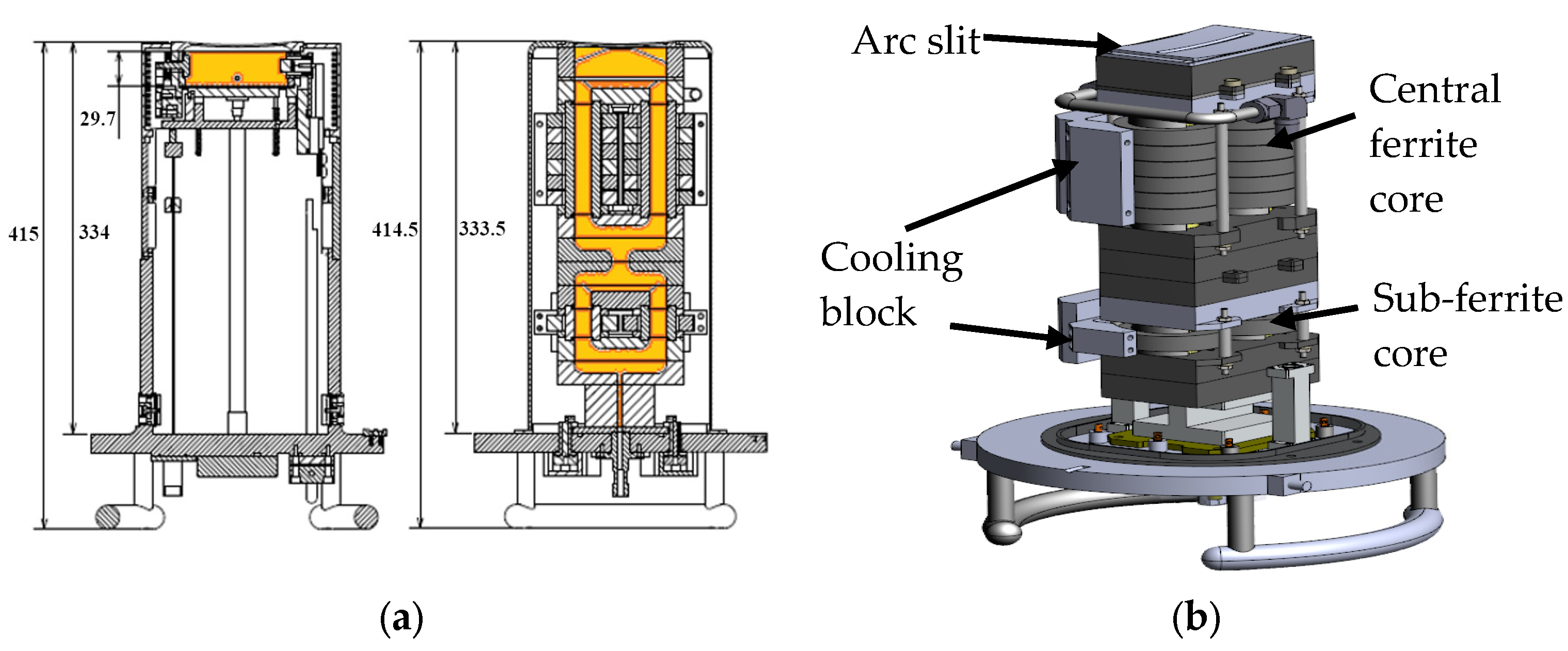
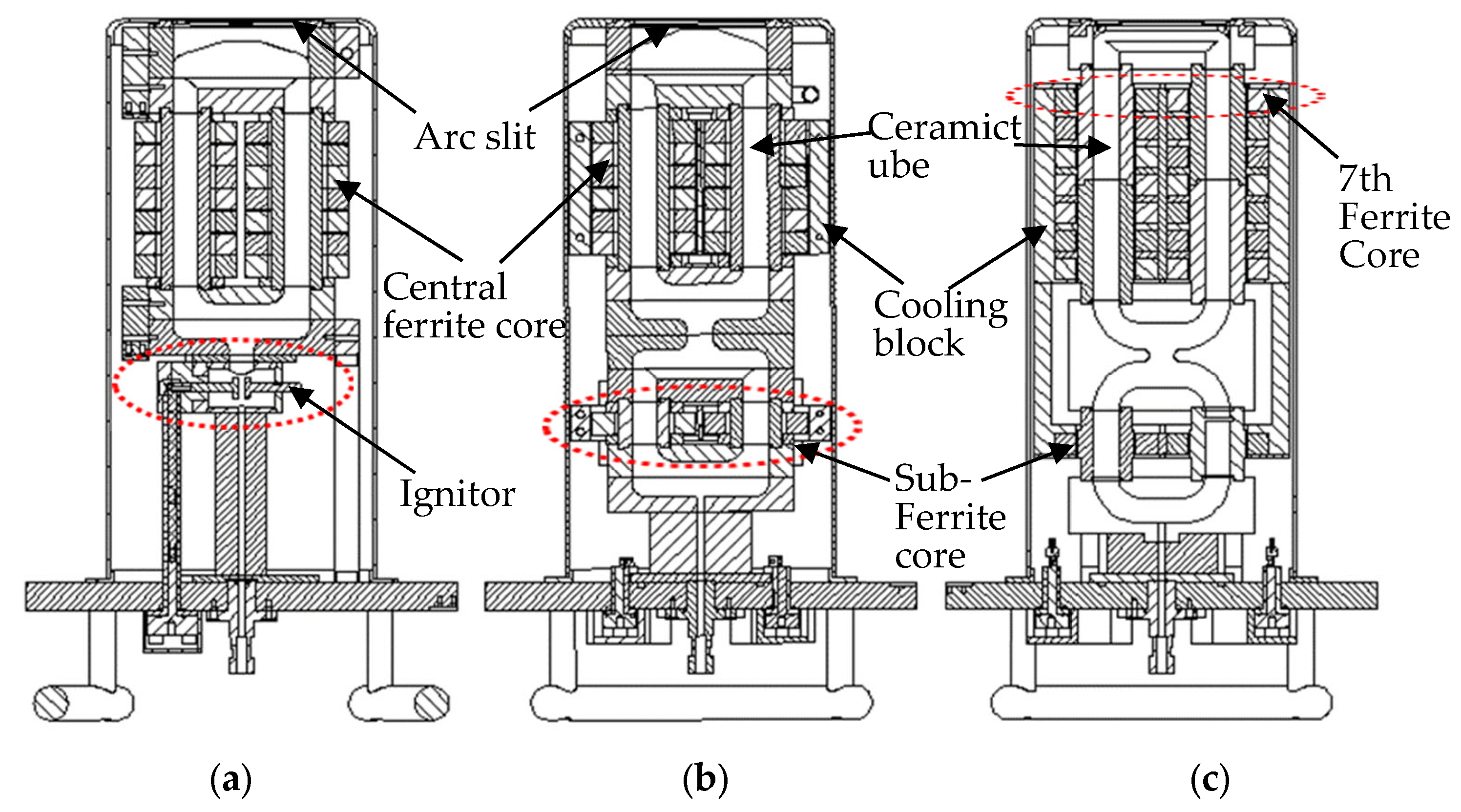
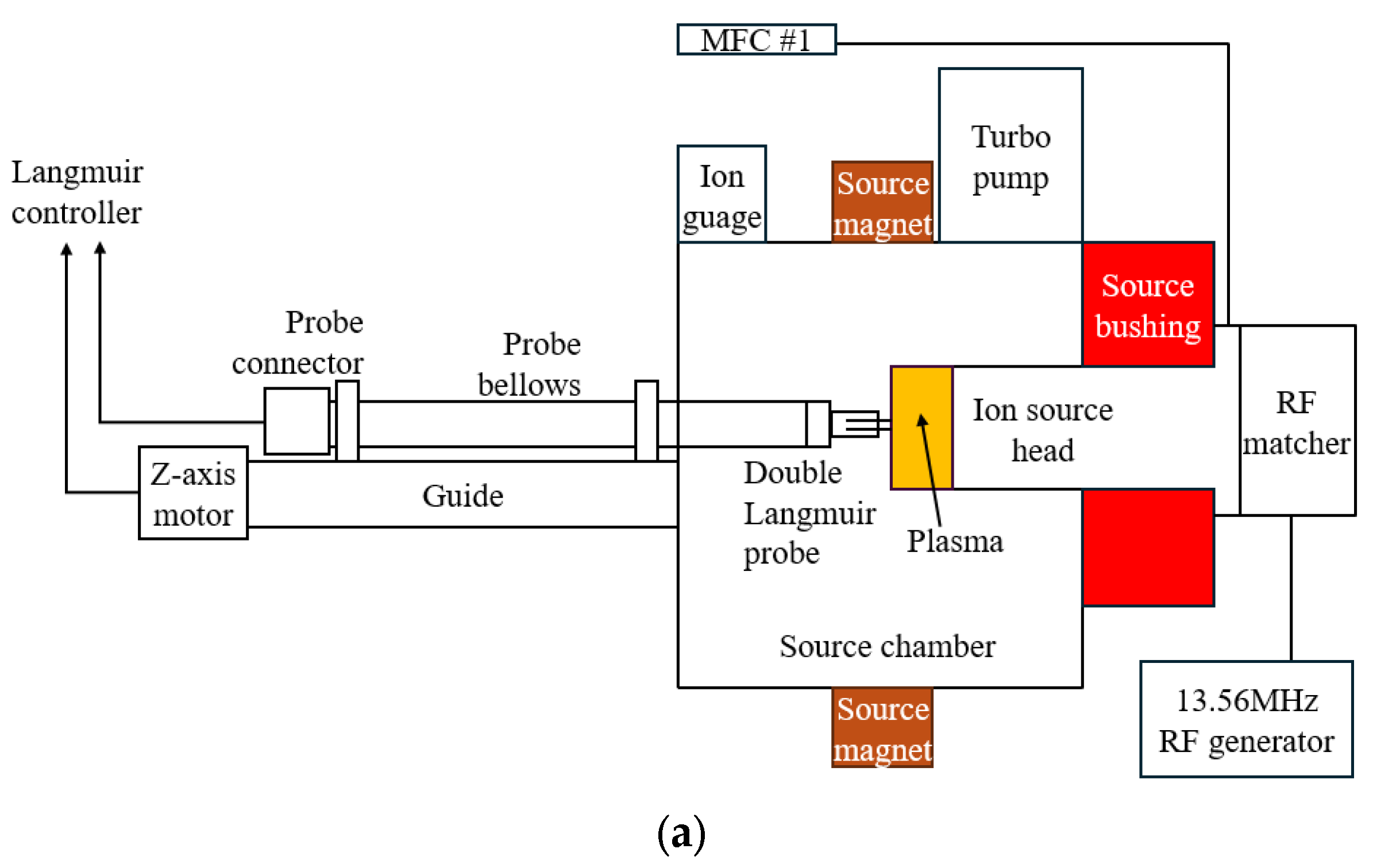

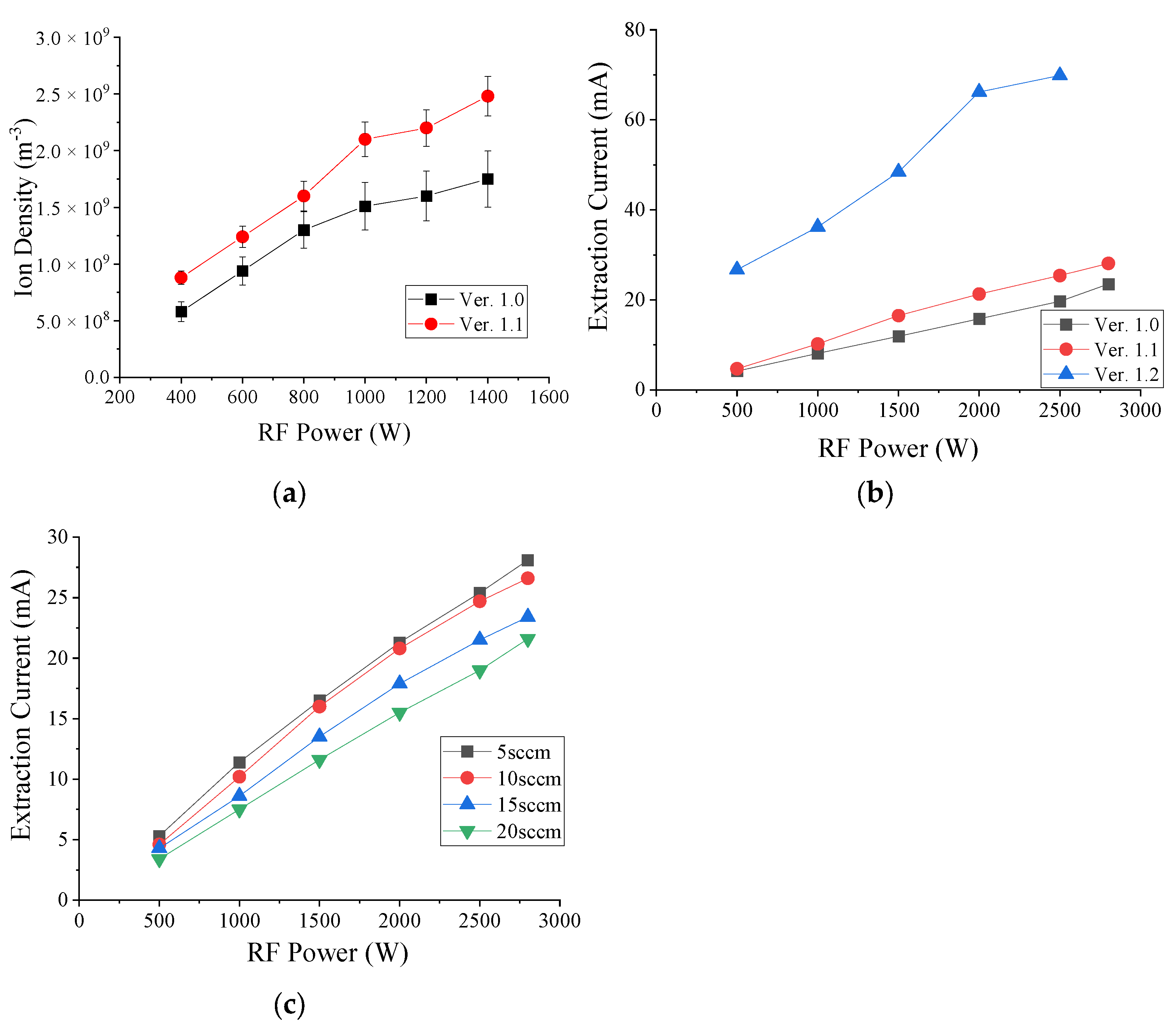
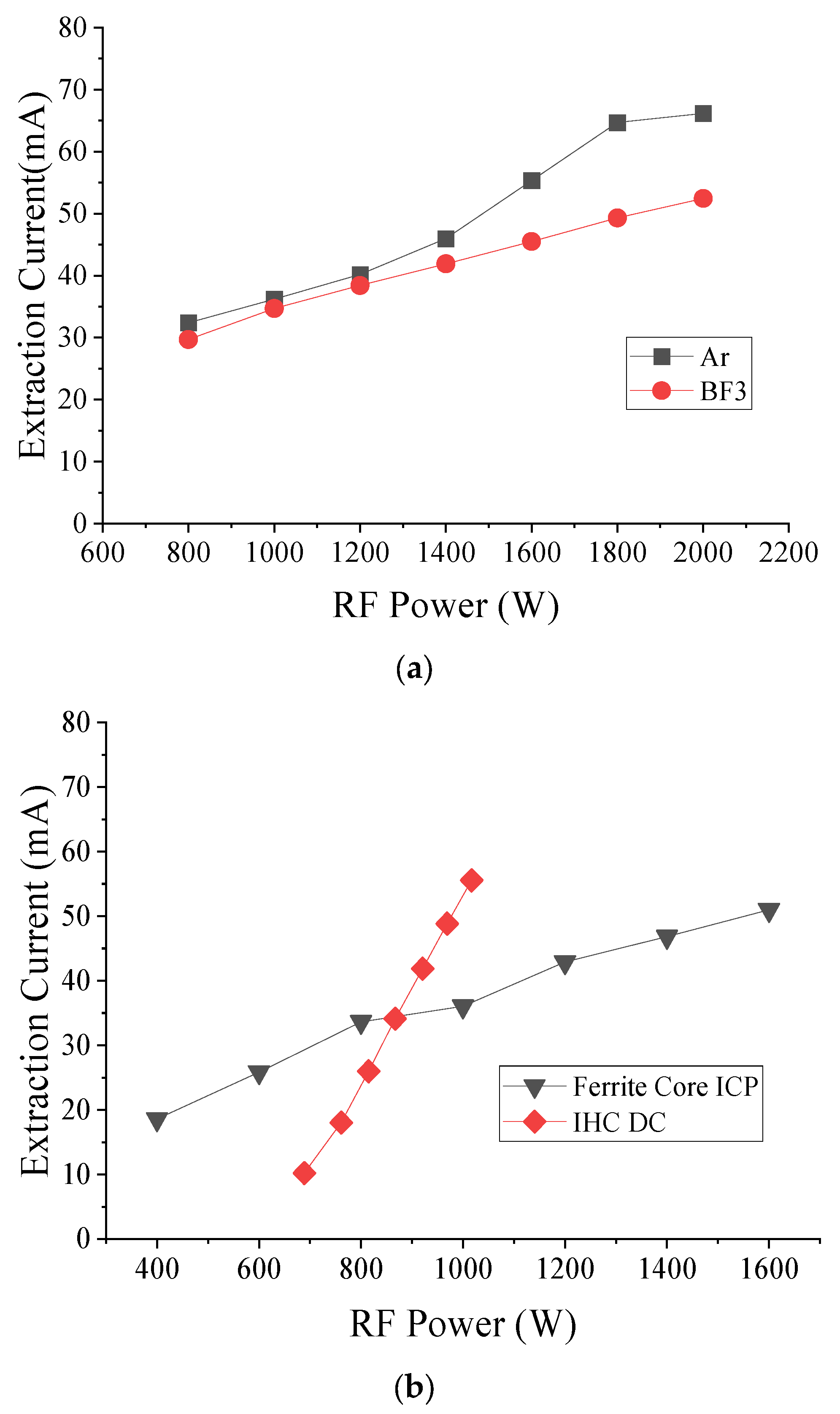
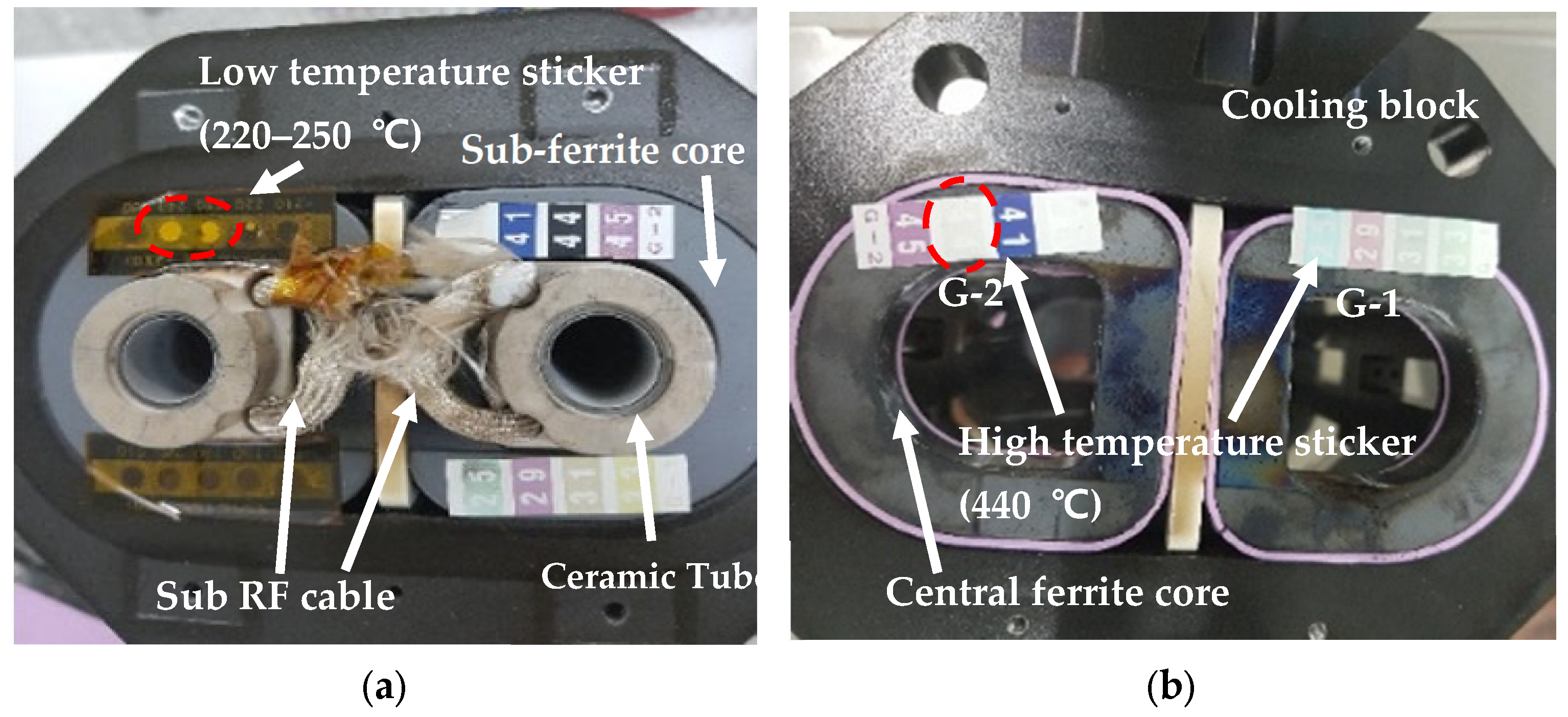
| Check Point | RF 2000 W, 8 h | RF 2000 W, 30 min |
|---|---|---|
| Sub-ferrite core | 250 °C | 210 °C |
| Central ferrite core | 440 °C | 250 °C |
| Arc slit aperture | 450 °C | 450 °C |
| Sub cable | 450 °C | 450 °C |
| Central cable | 210 °C | 210 °C |
Disclaimer/Publisher’s Note: The statements, opinions and data contained in all publications are solely those of the individual author(s) and contributor(s) and not of MDPI and/or the editor(s). MDPI and/or the editor(s) disclaim responsibility for any injury to people or property resulting from any ideas, methods, instructions or products referred to in the content. |
© 2024 by the authors. Licensee MDPI, Basel, Switzerland. This article is an open access article distributed under the terms and conditions of the Creative Commons Attribution (CC BY) license (https://creativecommons.org/licenses/by/4.0/).
Share and Cite
Hwang, J.-J.; Sim, H.-J.; Moon, S.-J. Development and Evaluation of Ferrite Core Inductively Coupled Plasma Radio Frequency Ion Source for High-Current Ion Implanters in Semiconductor Applications. Sensors 2024, 24, 5071. https://doi.org/10.3390/s24155071
Hwang J-J, Sim H-J, Moon S-J. Development and Evaluation of Ferrite Core Inductively Coupled Plasma Radio Frequency Ion Source for High-Current Ion Implanters in Semiconductor Applications. Sensors. 2024; 24(15):5071. https://doi.org/10.3390/s24155071
Chicago/Turabian StyleHwang, Jong-Jin, Hyo-Jun Sim, and Seung-Jae Moon. 2024. "Development and Evaluation of Ferrite Core Inductively Coupled Plasma Radio Frequency Ion Source for High-Current Ion Implanters in Semiconductor Applications" Sensors 24, no. 15: 5071. https://doi.org/10.3390/s24155071





